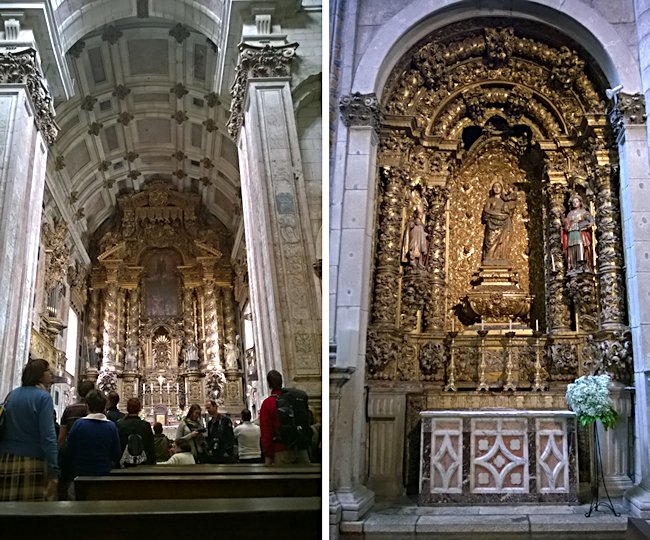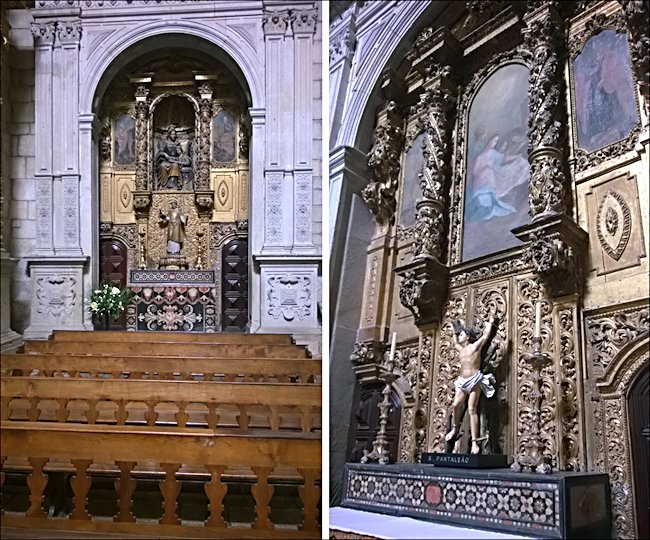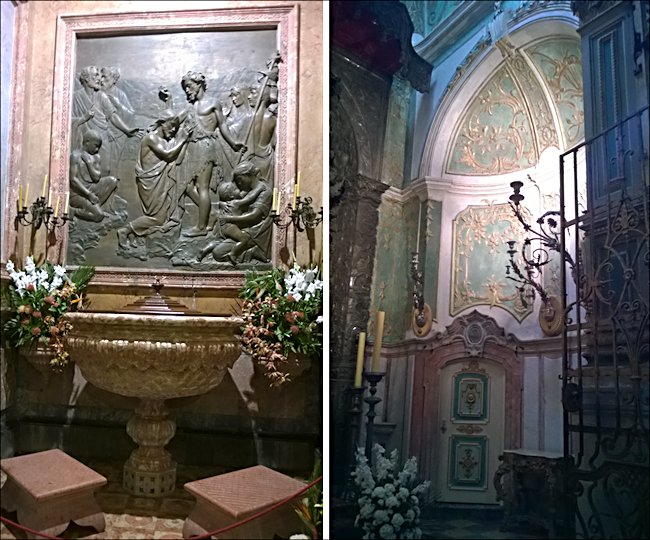Porto Cathedral's Interior
The main section of the Cathedral in Porto was built in the Romanesque style. This means that the architects copied many of the features found on buildings throughout the Roman Empire. Columns and semicircular rounded arches are a major feature of Romanesque buildings. This style was popular in mediaeval Europe between the 6th and 10th centuries. The austere large tall stone columns and wooden bench seating are a dramatic contrast to the richly decorated main and side altars and chapels.

Porto's Cathedral main alter and side mother and child altar
The inside of the cathedral has gone through many changes over the years. New altars were added as rich merchants, kings and nobleman sponsored their construction as a way of guaranteeing their place in heaven.
Philippa of Lancaster, daughter of John Gaunt the English 1st Duke of Lancaster, was married in a grand ceremony in the cathedral to King (Joao) John I of Portugal in 1387. Their famous son, Prince (Enrique) Henry the Navigator, was baptised at the altar. He went on to encourage the Portuguese Navy captains to explore the unknown world and claim large areas of land for the Portuguese Empire. King John I ruled for 50 years and that time is often referred to as a golden age in the history of Portugal.
In the 18th century rich baroque embellishments were added to the interior of the cathedral. A new aspe was decorated with wall paintings by the famous baroque artist Nasoni. New choir stalls were added that were carved in the baroque style. The most famous addition to the cathedral during this time was the silver altarpiece of the Chapel of the Holy Sacrament.

Two side alters in Porto's Cathedral
A local story states that in 1809, when Napoleon's Army entered the Porto, priests and members of the congregation painted the altar to hide the silver. The French troops never noticed what it was made of and left the silver alone.
As a contrast to the silver alter the chapel called Capela de S. Vicente has a golden altarpiece. Look out for the three red marble holy water fonts, supported by statue also carved in the baroque fashion. Christ's baptism by John the Baptist was the theme used by the artist Antonio Teixeira Lopes when he created the bronze bass-relief in the baptistery.
During the Battle of Amarante Spanish troops captured and took control of Porto's Cathedral. The local population was inflamed by this action and battled the troops to regain control of their beloved cathedral. Many people died. To commemorate their sacrifice a memorial plaque was fixed to the wall of the cathedral. What is unusual about this plaque is that it is backed with magnetite. The idea is that it would draw visitors to its location if they carried a compass.

Porto's Cathedral plinths and decoration
The opening hours of the Cathedral are:
Mon-Sat.: 8:40 am-12:30 pm; 14:30 pm-18:00 pm
Sunday and public holidays: 8:30am-12:30pm; 14:30pm-18:00pm
From April to October the cathedral closing time is at 19:00 pm
The Gothic Cloister's opening hours are:
Mon-Sat.: 9:00am-12:15pm; 14:30pm-17:15 pm
Sunday and public holidays: 14:30pm-17:15 pm
From April to October the closing time is at 18:00 pm.
Travel Books


Tweet